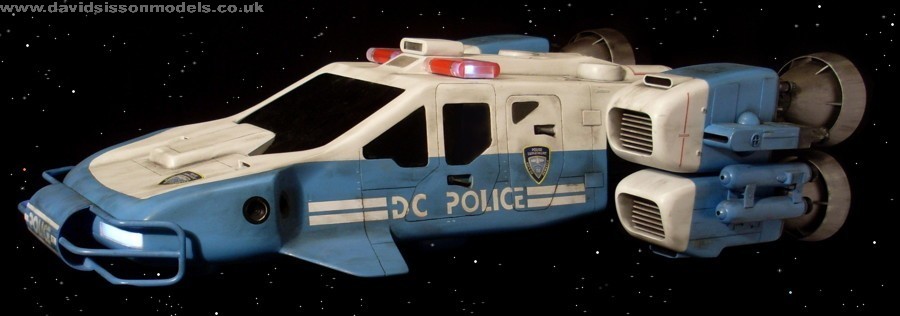![]()
Chasing bad guys in the Precinct Cruiser from Gerry Anderson's Space Precinct
|
|||
| That attempt also incorporated another of Gerry's old ideas of mixing his famous puppet work with live-action, which he had tried before with 'The Secret Service. However several years later he did manage to secure a deal on the basic space cops idea, a larger budget was acquired and so the puppets went out of the window as his live-action series, now renamed 'Space Precinct', began shooting. | |||
 |
|||
|
|||
 |
|||
|
Like Gerry's past series each
episode was to feature a wealth of special effects work
achieved with good old-fashioned model work, and as the
characters would need a fancy Sci-Fi vehicle to travel
around in so the Precinct Cruiser was born. This
craft was initially created by series Special Effects
Director Steven Begg - see Space
Precinct SFX interview - and was a streamlined
combination of helicopter and Space Shuttle. However the
Producers wanted something that looked more like a Police
car - so a bonnet was stuck on the front! |
 |
As usual I collected together a
multitude of reference photographs to aid in my
construction and managed to draw up a blueprint to a
30" sized model. I began by blocking out the main
hull in MDF sheeting; although the front bonnet area was
done with MDF just forming the outline shapes and then
adding Balsa wood sections to get the curvy edges. Things
were going along reasonably well when a friend suddenly
said 'Would you like to use the studio hull moulds?' Doh! |
 |
The resulting casting appeared to
come out rather well, and filled with enthusiasm I
quickly painted it in preparation for the next stage.
However problems began to become evident with minor
distortions in several areas, particularly under the nose
and top rear section. Disillusioned by the project I put
the casting on a shelf and forgot about it for six years! |
 |
Above: the 'DC Police' lettering
was simply done using the outlines in the surface
casting. Masking tapes were applied to cover the white
primer. |
|
The engine units were full
scratchbuilds starting with shapes formed in MDF,
plastic, and filler. The original plan was to use these
but I decided to cast the shape in fibreglass instead.
These shapes were revised many times before I was happy
with them. I kept placing the units in position and
adjusting the various spacings and dimensions to get them
to match up to the hull - certainly the upper engine
changed a fair bit during this process - and I think I
was slightly confused by my reference photos showing the
two studio models, which appear to have differences in
these areas. |
|
The engine units on the two big
studio models did vary slightly so I just picked the
details that I preferred, with most of it done in
plasticard with a few modified model kit parts. There are
a number of what appears to be kit parts on the engines,
but I failed to identify any of them and had to resort to
scratchbuilding copies. The twin missiles on the sides
were large plastic knitting needles with some plasticard
wrapped around them to bring them up to the correct
diameter, with the ends being formed from domes taken out
of the Revill Gemini kit. Other similar domes were cut
down to make both the front nose and rear thrusters. The
small intakes were formed in plastic sheeting with the
curved edges made by splitting a section of plastic tube
down the centre, and then the grill was cut from a fine
metal mesh. |
|
The engine bells gave me a bit of a
headache due to there size. I began by making the shape
of a bell and managed to almost get the shape straight
away by gluing together some plastic bells that I had in
stock. The exact shape was achieved as usual with the
application of car filler and plenty of sanding. |
 |
The bull bars were the next
problem. They are 1/8th thick on the small 1/2-scale
studio model so I assumed that they would be 1/4 inch on
this size, but instead they are smaller at 3/16ths.
Apparently they are also made from plastic tube, with a
metal rod down the centre to allow them to be bent to
shape, but that did make them easy to damage. |
|
I have started adding lights to
some of my models and the Police Cruiser was
calling out for them to be used, especially for the
rotating beacons. On the studio models a motor rotated
reflector cups around two bulbs, but as I didn't want a
motor or the noise that might go with it I bought two
sets of flashing LEDs off ebay. These sets are very
useful as they have a controller allowing me to set the
flash sequence and the speed, or have some of the lights
permanently on. This combination would give me the
beacons, headlights, and a flashing navigation light on
the roof and belly. |
 |
For a long while I intended to have
the model sitting on its tricycle undercarriage, but I
prefer the flying version which meant that I only had to
build the footpads. The basic forms were created by
gluing several layers of perspex together and then
shaping them using a beltsander, with detail areas added
using plasticard. Unfortunately I didn't have matching
ridged plasticard (or whatever it was originally) for the
tread pattern, so had to do it the hard way by gluing
dozens of individually cut plastic strips into place. |
 |
|||
|
|||
| Article and photographs copyright David Sisson 2014 |